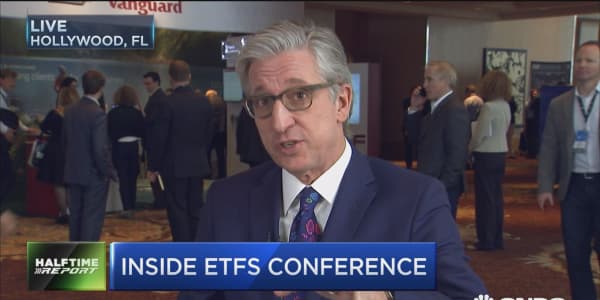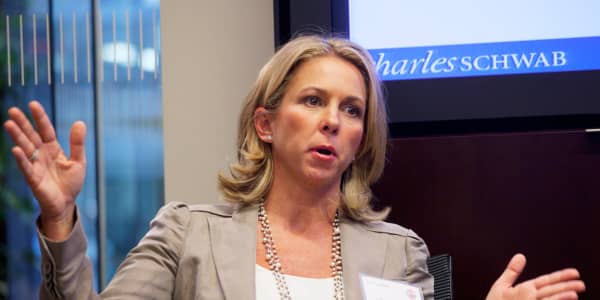The ETF.com "Inside ETF" conference is in full swing, with a record 2,200 participants jamming the Diplomat Hotel in Hollywood, Florida.
Here are the five questions I am most commonly asked about exchange-traded funds.
1) How big is the ETF business?
It's big and getting bigger. There is $2.1 trillion in ETF assets under management in the U.S. At the end of 2015, $3 trillion worldwide. That is still small in comparison to the roughly $11 trillion in assets under management at mutual funds, but the mutual funds have been steadily losing assets for years.
ETFs are cheaper and more tax efficient than most mutual funds. They are simply a better deal for most investors. There are now north of 1,600 ETFs, and more than 70 ETF providers.
2) How big is ETF trading?
It's big, too. Credit Suisse estimated that 2015 trading in ETFs made up 29 percent of the dollar value of daily U.S. equity trading.
Think about that. Nearly 30 percent of the dollar value of all U.S. trading were in ETFs.
That's a lot of trading.
This year, it's been even bigger. In the first week of January, ETF trading averaged $111 billion per day. That was 33 percent of the dollar value of all U.S. exchange trading.
You see why everyone is paying attention to ETFs? You see why I spend so much time reporting on them
3) Do ETFs "cause" volatility in the stock market?
The short answer is no.
It's certainly true that ETF trading is more correlated to volatility than trading in individual stocks. Credit Suisse — and other firms that have studied ETFs — have noted that higher levels of volatility, as measured by the VIX, correspond to more active ETF trading.
But this makes perfect sense. Why? Credit Suisse explains:
- ETFs are often used for "tactical allocation," that is, they're used by professionals who actively trade the market. It's a good vehicle for hedging, shorting, and mean reversion trades.
- Volatility spikes often occur around macroeconomic concerns, which affect all stocks: "Index-linked derivatives (such as futures and ETFs) are natural vehicles for expressing broad market views," Credit Suisse notes.
- ETFs have market makers who arbitrage the value of the ETF against the value of the underlying stocks. This is a large percentage of ETF trading in general. When markets are volatile, prices swing in a broader range (as they have this year), and that creates more opportunities for market participants because there are wider spreads.
In other words, there is more trading of ETFs when volatility is higher, but higher ETF trading is an effect of volatility, not a cause.
4) Doesn't all this ETF trading cause churning in the underlying stocks?
Not as much as you would think. Most ETFs are linked to an index, and there is an underlying basket of stocks behind the ETF.
But Credit Suisse estimated that trading in the underlying stocks occurs only about 15 percent of the time.
In other words, ETFs typically trade without ever seeing trading in the underlying stocks. The market makers create the ETFs by giving custodians the underlying basket of stocks, and they in return receive shares in the ETFs. For the most part, those shares trade without having to trade the underlying stocks.
5) What about leveraged and inverse ETFs? Are they dangerous?
I'm not convinced they are a danger to the markets, but the average investors should stay away from them.
The SEC recently announced it would begin looking into ETF sales strategies and disclosures and the suitability for investors of complex ETFs like leveraged and inverse ETFs.
I am not a fan of leveraged and inverse ETFs. I don't like them because they reset their returns on a daily basis and because of that, no investor will get the return they think they are getting if they hold these securities for any length of time, particularly if there is a lot of volatility.
I'll give you an example that illustrates the "reset" problem. Last year the S&P 500 was up 1.3 percent on a total return basis (including dividends). If you owned a leveraged ETF that, for example, guaranteed you twice the return of the S&P, you would think you would make 2.6 percent (1.3 percent times 2).
But the ProShares Ultra ETF, which does give you 2 times leverage, was down 1.08 percent last year.
If you owned an inverse ETF that, for example, guaranteed you twice the inverse of the S&P, you might think you would be down 2.6 percent. But the ProShares UltraShort S&P 500, which guaranteed you twice the inverse of the S&P 500, was down 9.6 percent.
What happened? Just what the funds advertised: They only guarantee you the return on a daily basis. Once you're past that, the returns will vary.
Because of this, these types of investments should only be used by sophisticated investors who understand what the funds are promising.
And that's why the SEC is looking into this. Regulators want to make sure no one is surprised.
Past the suitability issue, I have doubts that regulating them out of existence is the right way to go.
First, they are a tiny part of the market. ETFs are a $2 trillion market. Leveraged and inverse ETFs probably account for $30 billion of that, less than 2 percent.
Second, for the most part these instruments consist of a pile of cash and a swap agreement with a counterparty, usually a big bank. The funds go to the bank and say, "If the S&P is up 1 percent, you will pay us 2 percent today. If the S&P is down 1 percent, we will pay you 2 percent." It's a swap agreement that is collateralized. Money changes hands.
I'll be reporting from the conference all day Monday and Tuesday. Stay tuned to this space for more.







